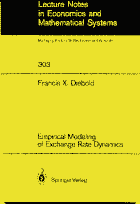|
Books
    
Diebold,
F.X. and Yilmaz, K. (2015), Financial
and Macroeconomic Connectedness: A Network Approach to Measurement and
Monitoring, Oxford University Press. Front matter and T.O.C. here.
Diebold,
F.X. and Rudebusch, G.D. (2013), Yield Curve
Modeling and Forecasting. Princeton: Princeton University
Press. First chapter here.
Insightful Riccardo Rebonato review here.
Understanding the dynamic evolution of the yield curve is critical to many
financial tasks, including pricing financial assets and their derivatives,
managing financial risk, allocating portfolios, structuring fiscal debt,
conducting monetary policy, and valuing capital goods. Unfortunately, most yield curve models tend to be theoretically rigorous
but empirically disappointing, or empirically successful but theoretically
lacking. Against that background, we propose two extensions of the classic
yield curve model of Nelson and Siegel that are both theoretically rigorous
and empirically successful. The first extension is the dynamic Nelson-Siegel
model (DNS), while the second takes this dynamic version and makes it
arbitrage-free (AFNS). We emphasize both descriptive and efficient-markets
aspects, we pay special attention to the links between the yield curve and
macroeconomic fundamentals, and we show why DNS and AFNS are likely to remain
of lasting appeal even as alternative arbitrage-free models are developed.
Diebold,
F.X. (2012), Financial Risk
Measurement and Management (ed.). Cheltenham, U.K. and Northampton,
Mass.: Edward Elgar Publishing Ltd. (International Library of Critical Writings in Economics, Volume 267).
Click here for first chapter.
Classics
old and new. In the interpretive introductory chapter
I selectively survey several key strands of literature on financial risk
measurement and management. I begin by showing why there's
a need for financial risk measurement and management, and then I turn to
relevant aspects of return distributions and volatility fluctuations, with
implicit emphasis on market risk for equities. I then treat market risk for
bonds, focusing on the yield curve, with its nuances and special structure.
In addition to market risk measurement and management, I also discuss aspects
of measuring credit risk, operational risk, systemic risk, and underlying
business-cycle risk. I nevertheless also stress the limits of statistical
analysis, and the associated importance of respecting the unknown and the
unknowable.
Diebold,
F.X., Doherty, N. and Herring, R. (2010), The Known, the
Unknown and the Unknowable in Financial Risk
Management: Measurement and Theory Advancing Practice (ed.).
Princeton: Princeton University Press. (2012 Recipient of the American Risk
and Insurance Association's Kulp-Wright Award;
finalist for the Paul A. Samuelson Award, TIAA-CREF).
On the successes and failures of various parts of modern financial risk
management, emphasizing the known (K), the unknown (u) and the unknowable (U). We illustrate a KuU-based
perspective for
conceptualizing financial risks and designing effective risk management
strategies. Sometimes we focus on K, and sometimes on U, but most often our
concerns blend
aspects of K
and u
and U.
Indeed K
and U
are extremes of a smooth spectrum, with many of the most interesting and
relevant situations interior. Statistical issues emerge as central to risk measurement,
and we push toward additional progress. But economic
issues of incentives and strategic behavior emerge as central for risk management,
as we illustrate in a variety of contexts.
Bernadel, C., Cardon, P., Coche,
J., Diebold, F.X. and Manganelli, S. (2004),
Risk Management for Central Bank Foreign Reserves
(ed.). Frankfurt: European Central Bank.
Central
banks manage huge forex portfolios. It would be socially irresponsible for
them to manage those portfolios like aggressive and risky hedge funds, yet it
would presumably be similarly socially irresponsible for them to settle for a
risk-free return. So how should central banks manage their portfolios? This book
grapples with that interesting question.
Diebold,
F.X. and Rudebusch, G.D. (1999), Business
Cycles: Durations, Dynamics and Forecasting, Princeton:
Princeton University Press.
A
collection of our papers in time-series macro-econometrics, with an interpretive introductions. Includes material on
the analysis of business cycle durations, long memory, regime switching,
leading indicators, turning points, and predictive accuracy comparisons.
Diebold,
F.X. (1988), Empirical
Modeling of Exchange Rate Dynamics. New York and Berlin: Springer-Verlag.
My
1986 Ph.D. dissertation, written in 1984-1985, showing that ARCH effects are
important in asset returns. Hard to believe from today's vantage point, but
that was a very novel result at the time! Also contains work on testing for
serial correlation in the presence of ARCH, Gaussian CLTs for ARCH processes
(so that temporal aggregation reduces the fat tails in unconditional
distributions), and multivariate latent-factor ARCH.
|




